

Media Report Card
Off the Charts
Accuracy in Reporting of Israel/Palestine
ABC World News Tonight
CBS Evening News
NBC Nightly News
Study Periods:
September 29, 2000 - September 28, 2001
January 1, 2004 - December 31, 2004
Abstract
This study consists of a statistical examination of ABC World News Tonight, CBS Evening News, and NBC Nightly News coverage of the first year of the current Palestinian uprising, and of their coverage of that uprising in 2004. The categories examined are coverage of conflict deaths and, as a subcategory, children’s deaths. Our findings indicate significantly distorted coverage by all of these network news shows. In the first study period ABC, CBS, and NBC reported Israeli deaths at rates 3.1, 3.8, and 4.0 times higher than Palestinian deaths, respectively. In 2004 these rates increased or stayed constant, to 4.0, 3.8, and 4.4, widening still further, in the case of ABC and NBC, the disparity in coverage. An additional sub-study of deaths reported in introductions revealed a similar but even larger disparity. The networks’ coverage of children’s deaths was even more skewed. In the first year of the current uprising, ABC, CBS, and NBC reported Israeli children’s deaths at 13.8, 6.4, and 12.4 times the rate of Palestinian children’s deaths. In 2004 these large differentials were also present, although they decreased in two cases, with deaths of Israeli children covered at rates 9.0, 12.8, and 9.9 times greater than the deaths of Palestinian children by ABC, CBS, and NBC, respectively. Given that in 2004 22 times more Palestinian children were killed than Israeli children, this category holds particular importance. We could find no basis on which to justify this inequality in coverage.
Introduction
Beginning in 2003, If Americans Knew1 began issuing report cards to media across the country on their coverage of the Israeli-Palestinian conflict. This study of ABC World News Tonight, CBS Evening News, and NBC Nightly News (we will call them, collectively, the networks) covers the first year of the current uprising (September 29, 2000 through September 28, 2001). This period was selected for study because it set the context within which all subsequent reporting on the conflict is viewed. We also studied these networks’ coverage for 2004 to discover whether the patterns we found for the first year had continued, diminished, or increased.
Given that the media have a desire and a responsibility to cover this topic accurately, we provide these reports in the hope that our analyses can assist them in achieving this goal.
In addition, we are making these reports public, as a way to help viewers evaluate for themselves the reliability of their sources of information on this issue.
The goal of this report is to
- Establish clear standards for assessing accuracy in reporting.
- Provide, in a consistent format, an assessment of the media’s accuracy in reporting on the Israel/Palestine conflict.
Methodology
We recognize that reporting on Israel/Palestine has been an exceptionally controversial topic. Therefore, while there are many potential yardsticks for measuring accuracy, we chose criteria that would be widely acknowledged as significant, conducive to statistical analysis, and immune to subjective interpretation.
We chose to focus on the reporting of deaths, because this allows meaningful statistical analysis that would be impossible in a qualitative study. This unambiguous yardstick allows us to determine whether media demonstrate even-handed respect for human life, regardless of ethnic or religious background. Fortunately, accurate data for both populations is available from the widely respected Israeli human rights organization, B’Tselem2. We only included Israeli deaths directly caused by the actions of Palestinians, and vice versa. In addition, we did not examine the coverage of killings that took place outside Israel and Palestine.
As a subcategory, we investigated the coverage of children’s deaths, since children are illegitimate targets of violence. Each such death represents a universally recognized human tragedy, and we felt it would be important to study how the media are covering these events among both populations.
Another sub-category examined was deaths reported in introductions, since these bring added attention and emphasis to such reports.
Finally, we gathered data on the networks’ reporting of cumulative death counts. While such cumulative statistics are not equivalent to individual reports on the deaths, they can provide useful contextual information, particularly when appended to high-quality daily reporting.
For this study we used the LexisNexis database to access transcripts of all of the ABC, CBS, and NBC evening news programs broadcast during our study periods.
Findings:
I. Coverage of All Deaths: First Year of the Uprising
During the first year of the current uprising, 165 Israelis were killed by Palestinians and at least 549 Palestinians were killed by Israelis.3 The majority of those killed among both populations were civilians.

|
Examining this first year of news coverage, we found a significant disparity in the likelihood of a death being reported based on the ethnicity of the person killed.
This disparity was compounded by the fact that while the networks periodically reported on deaths more than once, through follow-up stories and mentions in later news reports, such repetitions were found to be more frequent in reporting on Israeli deaths than in reporting on Palestinian deaths. In fact, such repetitions caused the networks in some cases to report on Israeli deaths in greater rates than they had actually occurred. Palestinian deaths, on the other hand, were significantly under-reported by all three networks.
In its first year of coverage, we found that ABC reported on 305 Israeli deaths and 327 Palestinian deaths – 185% of Israeli deaths and 60% of Palestinian deaths.
CBS reported on 334 Israeli deaths and 296 Palestinian deaths – 202% of Israeli deaths and 54% of Palestinian deaths.
NBC reported on 227 Israeli deaths and 190 Palestinian deaths – 138% of Israeli deaths and 35% of Palestinian deaths.
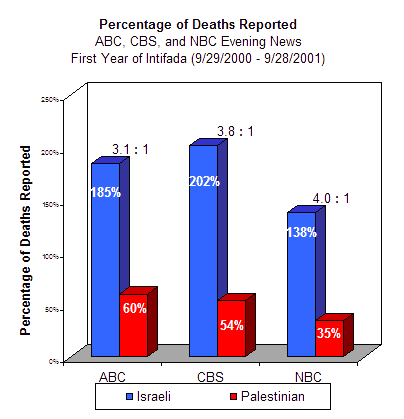
|
In other words, ABC reported Israeli deaths at a rate 3.1 times greater than Palestinian deaths, CBS reported Israeli deaths at a rate 3.8 times greater than Palestinian deaths, and NBC reported Israeli deaths at a rate 4.0 times greater than Palestinian deaths.
On average, the networks reported Israeli deaths at a rate 3.5 times greater than Palestinian deaths (175% of Israeli deaths and 49% of Palestinian deaths).
II. Coverage of Children’s Deaths: First Year of the Uprising
In the first year of the current uprising, 28 Israeli children and at least 131 Palestinian children were killed.4 (Children are defined by international law as those who are 17 and younger.)
Thus, Palestinian children were killed at a rate 4.7 times greater than Israeli children. 825 of these Palestinian children were killed in the first three-and-a-half months of the conflict, before any Israeli children had been killed.

|
During the conflict Palestinian children have consistently made up a disproportionately large number of Palestinian deaths. In this first year children’s deaths accounted for 24% of the Palestinians killed, while children’s deaths accounted for 17% of Israelis killed.
During this time, ABC reported on 56 Israeli children’s deaths (including repetitions in later newscasts) and 19 Palestinian children’s deaths – 200% of Israeli children and 15% of Palestinian children, a ratio of 13.8 to 1.
CBS reported on 37 Israeli children’s deaths (including repetitions) and 27 Palestinian children’s deaths – 132% of Israeli children’s deaths and 21% of Palestinian children’s deaths, a ratio of 6.4 to 1.
NBC reported on 45 Israeli children’s deaths (including repetitions) and 17 Palestinian children’s deaths – 161% of Israeli children and 13% of Palestinian children’s deaths, a ratio of 12.4 to 1.

|
Collectively, the networks reported on an average of 46 Israeli children’s deaths – 164% of the Israeli children killed – and 21 Palestinian children’s deaths – 16% of the Palestinian children killed. In other words, the networks reported on Israeli children’s deaths at a rate 10.2 times greater than Palestinian children’s deaths.
To understand the pattern of network news coverage of children’s deaths, it is useful to compare the number of deaths reported to the actual number that took place. While repeated coverage of Israeli children’s deaths creates an impression of a higher number of Israeli victims than there actually were, omissions of the majority of Palestinian children’s deaths considerably under-represents the number of Palestinian child victims.

|
Comparing the day-by-day reporting of children’s deaths to the actual daily death toll reveals an additional dimension of the distortion. In this comparison, we discover that the reports on Palestinian children’s deaths followed the curve for Israeli children’s deaths, rather than the much steeper curve of their actual death count.
This finding underscores the tendency by all three networks to report a fictional situation in which Israeli and Palestinian deaths occur at more or less the same rate, and illustrates the substantial gap between the reality of Palestinian fatalities and the coverage of them. It suggests that the desire to appear ‘balanced’ is too often prioritized above the need for accuracy.
Chronological Running Totals of Children’s Deaths – Reported and Actual
First Year of Uprising (9/29/2000 – 9/28/2001)
 |
 |
 | |
III. Coverage of Deaths in Introductions: First Year of the Uprising
As another sub-category, we looked at the networks’ reports of deaths in introductions to newscasts, since such anchor lead-ins tend to lend additional emphasis to a report. Interestingly, for all three networks the disparity in coverage found in full newscasts grew even larger in this category.
ABC reported on 99% of Israeli deaths and 25% of Palestinian deaths in introductions. Hence, an Israeli death was 4.0 times more likely to receive coverage than a Palestinian death in the introduction, an even larger disparity than the ratio of 3.1 found in ABC’s coverage in full newscasts.
CBS reported Israeli deaths at a rate 5.8 times greater than Palestinian deaths in introductions. (128% of Israeli deaths and 22% of Palestinian deaths were reported.) This is up from the ratio of 3.8 to 1 present in coverage throughout full newscasts.
NBC’s rate of covering Israeli deaths over Palestinian deaths, 4.0 to 1 in full newscasts, grew to 5.9 to 1 when only introductions were studied. NBC covered 72% of Israelis killed compared to 12% of Palestinians killed in introductions.

|
IV. Coverage of All Deaths: 2004
In studying the networks’ 2004 coverage, we found that these patterns continued and, in many cases, increased.
During 2004 violence against Israelis had significantly decreased relative to the first year of the uprising. At the same time, violence against Palestinians was much higher than it had been in the first year.
In 2004, 107 Israelis were killed by Palestinians and at least 821 Palestinians were killed by Israelis.6 Thus the ratio of Palestinian to Israeli deaths was 7.7 to 1, more than double the first year’s ratio of 3.3 Palestinian deaths for each Israeli death.
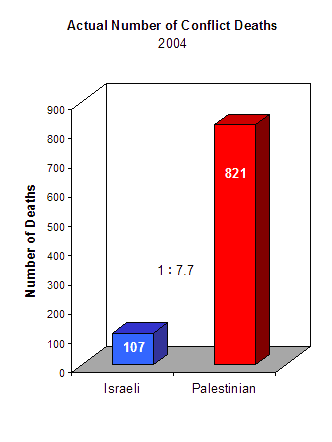
|
During this period, ABC reported on 168 Israeli deaths and 322 Palestinian deaths – 157% of Israeli deaths and 39% of Palestinian deaths, a ratio of 4 .0 to 1, up from 3.1 in its first year’s reporting.
CBS reported on 112 Israeli deaths and 227 Palestinian deaths – 105% of Israeli deaths and 28% of Palestinian deaths – a ratio of 3.8 to 1, the same ratio as its first year reporting.
NBC reported on 165 Israeli deaths and 287 Palestinian deaths – 154% of Israeli deaths and 35% of Palestinian deaths – a ratio of 4.4 to 1, up from 4.0 in the first year.
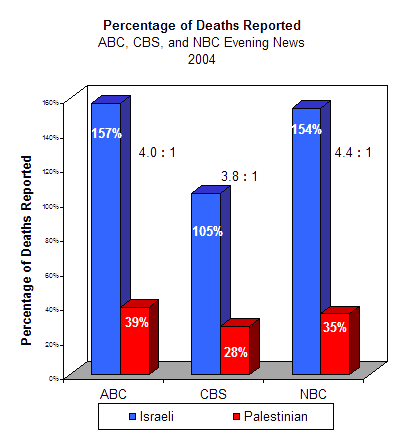
|
Taken together, then, the three networks reported on Israeli deaths, on average, at a rate 4.1 times greater than on Palestinian deaths, an increase over the 3.5 to 1 average ratio during the first year of the uprising.
V. Coverage of Children’s Deaths: 2004
In 2004, as with adults, fewer Israeli children and more Palestinian children were killed than in the first year of the conflict.
Eight Israeli children and 179 Palestinian children were killed in 2004. This ratio of 22 times more Palestinian children killed than Israeli children was nearly a five-fold increase over the first year’s ratio of 4.7 to one.
Again, Palestinian children were making up a much greater part of the total number of Palestinians killed than Israeli children were of Israeli conflict casualties. Children’s deaths accounted for 22% of the Palestinians killed, while Israeli children’s deaths had decreased to only 7% of Israelis killed during this period.

|
ABC reported on 8 Israeli children’s deaths and 20 Palestinian children’s deaths – 100% of Israeli children and 11% of Palestinian children, 9.0 to 1, down from 13.8 in the first year.
CBS reported on 4 Israeli children and 7 Palestinian children – 50% of Israeli children’s deaths and 4% of Palestinian, a ratio of 12.8 to 1, up from 6.4 in the first year.
NBC reported on 8 Israeli children’s deaths and 18 Palestinian children’s deaths – 100% of Israeli children and 10% of Palestinian killed during 2004, a ratio of 9.9, down from 12.4.
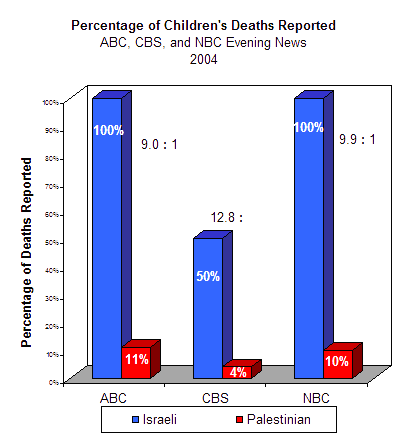
|
On average, the networks reported 83% of Israeli children’s deaths and 8% of Palestinian children’s deaths. That is, an Israeli death was 9.9 times more likely to be reported than a Palestinian death (compared to the first year’s ratio of 10.2 to one).
Visual representation of this pattern of omission gives a sense of the size of the disparity.

|
Comparing running totals for actual deaths and reported deaths once again reveals that television reporting on Palestinian children’s deaths followed virtually the same line as Israeli children’s deaths, in stark contradiction to the reality, in which Palestinian children were being killed at a rate 22 times greater than Israeli children. Again, all three networks revealed similar patterns of reporting.
Chronological Running Totals of Children’s Deaths – Reported and Actual
2004
 |
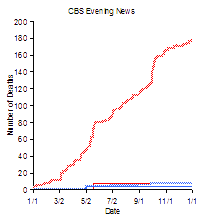 |
 |
|
VI. Coverage of Deaths in Introductions: 2004
In 2004 the trend of emphasizing Israeli deaths over Palestinian deaths, by reporting them at a higher rate in the introductions, continued.
ABC included mentions of 92% of Israeli deaths in introductions and only 10% of Palestinian deaths. That is, ABC covered Israeli deaths at a rate 9.68 times higher than Palestinian deaths, much higher than the ratio of 4.0 found in their coverage in full newscasts.
CBS’s rate of covering killings of Israelis over those of Palestinians was also greater in introductions: 4.7 to 1, up from 3.8 in full newscasts.
Only NBC’s ratio of coverage of Israeli deaths to Palestinian deaths dropped when we examined introductions in 2004: NBC covered Israeli deaths at a rate 3.6 times higher than Palestinian deaths in introductions, as opposed to the ratio of 4.4 in their full newscasts.

|
VII. Coverage of Cumulative Totals
In addition to counting daily reports of deaths, we examined the networks’ mentions of cumulative deaths: reports summarizing the number of deaths that had occurred over an extended period of time (longer than one week), rather than reports on specific incidents.
The most complete (and therefore most informative) type of cumulative report is what we call a full two-sided cumulative – a report of the total number of conflict deaths for both populations as of the date of the news report. Also useful in analysis are partial two-sided cumulatives: reports of the total number of conflict deaths for both populations over a period of time longer than one week, but shorter than the duration of the conflict or with some other limiting parameter.
Unfortunately, we found that full two-sided cumulative reports were almost never given, and partial two-sided cumulatives were only rarely given. Instead, we found that it was far more common for the networks to report one-sided cumulatives. These, whether full or partial, make it more difficult for the viewer to make a comparison and draw conclusions on the relative levels of violence. In fact, such one-sided cumulatives may at times do more to obscure understanding of the conflict than to enhance it.
In May of the first year ABC gave one full two-sided cumulative report on children’s deaths. CBS gave three full two-sided cumulatives, one of which included numbers of children killed. NBC also gave three full two-sided cumulative reports, although they were all in the first two months of the uprising. Additionally during this time, partial two-sided cumulatives were reported, twice by CBS and once by NBC.
In 2004, none of the networks reported a single full two-sided cumulative, and only CBS reported a partial two-sided cumulative, with the following remark on March 7: “Over the last year ... nearly 200 Israelis have been killed, more than 600 Palestinians as this conflict grinds on.”
The networks’ full one-sided cumulative reports display an interesting pattern.
All three networks reported full cumulatives of Palestinian deaths without corresponding numbers for Israelis in the first few months of the uprising, but quickly discontinued this practice: In the first two weeks of the uprising ABC twice reported the total number of Palestinians killed. CBS reported the total numbers of Palestinians killed once in the first month. NBC reported full cumulative numbers of Palestinian deaths five times, all in the first five months of the uprising, and once reported the full number of Palestinian children killed, in May of 2001. (Again, not counting the two-sided reports discussed above). The only full one-sided cumulative for Israelis during the study periods was reported by CBS in February, 2004; this was also the only full one-sided cumulative reported in 2004 by any of the networks.
Finally, one-sided cumulative reports fall into the following groupings:
- Numbers of Israelis killed by specific Palestinian organizations, people, or tactics (e.g. suicide bombings). Of this type, ABC reported four cumulatives (all in 2004), CBS reported two, and NBC reported ten.
- Numbers of Palestinians killed by specific Israeli tactics, e.g. the campaign of “targeted assassinations.” ABC provided such reports five times, CBS three, and NBC four. Notably, this type of report carries the suggestion that the victims are legitimate targets of military action.
- The remainder of cumulatives were simply reports of numbers of people killed in some extended period of time, possibly also in a limited area. ABC reported six of this third type (number of Palestinians killed along a specific road, number of Palestinians killed in Bethlehem, number of Israelis killed since Arial Sharon was elected Prime Minister of Israel, and three other Palestinian cumulatives). CBS reported this type once (Palestinian). NBC gave four reports of this kind (three Palestinian, one Israeli).
In examining these cumulative reports, a consistent pattern emerges in which cumulative reports of Israeli fatalities provide information on extensive periods of time – most often back to the beginning of the uprising, while cumulative reports of Palestinian deaths cover far shorter periods of time – often only weeks. Thus, similar numbers of deaths are reported in these cumulatives, despite the fact that throughout the conflict Palestinians have been killed in substantially larger numbers than Israelis.
Additional Notes
While gathering our data, we came across a number of additional patterns of distortion that merit further examination.
Most significantly, it appeared that context was largely missing from this reporting. While we realize that the exigencies of network news programming decree that reports be relatively short, there is an obligation, nevertheless, to ensure that brevity does not create inaccuracy. In particular, there seemed insufficient information on the unusual historic and geographic dimensions of this conflict. Many viewers, given the nature of the reporting, may not realize that in the multitude of fatal incidents Israeli armed combatants were invading and occupying Palestinian territories, not vice versa.
A few patterns of omission were particularly startling. The Israeli press, international human rights organizations, and medical relief agencies have all reported on the targeting of Palestinian children by Israeli forces. In the first year of the conflict, for example, at least 45 Palestinian children were confirmed to have been killed by Israeli gunfire to the head.9 Yet, two of the networks carried no reports on this disturbing phenomenon, and one network, CBS, reported on it only once (“...a 12-year-old boy shot in the head by an Israeli soldier...” 10/10/00).
Finally, while reports of deaths were repeated on both sides, we found a significant difference in the types of deaths repeated. Follow-up stories on Israeli deaths often focused on civilians. By contrast, repetitions of Palestinian deaths were primarily devoted to the deaths of combatants, particularly members of militant groups.
Such reporting significantly distorts the reality of the conflict, in which civilians are being killed in great numbers on both sides, and the number of Palestinian civilian deaths is considerably greater than the number of Israeli ones.10
Conclusions
It is sometimes said that the only uncontroversial aspect of the Israeli-Palestinian conflict is that it is controversial. Indeed, many news sources are simultaneously accused of displaying diametrically opposed biases. If Americans Knew has undertaken this study with the aim of providing objective, verifiable analysis of coverage.
The Middle East is currently among the most volatile regions in the world. The Israeli-Palestinian conflict is one of the central issues of this region, and intimately related to the escalating regional violence we see today. American forces are presently deployed in one country in the region, and it is uncertain when they will be withdrawn. More US tax money goes to Israel than to any other nation; and more American money is sent to the Middle East than to the rest of the world combined. For all these reasons and more, it is essential that Americans receive full and accurate news coverage on Israel/Palestine.
Unfortunately, our findings indicate that this is not occurring. Our analysis reveals troubling patterns of omission and disparities in emphasis that, we feel, profoundly hamper the ability of viewers to understand this conflict.
In the first year of the current uprising, when there were four times more Palestinians being killed than Israelis, two out of three networks reported on more Israeli deaths than Palestinian deaths. This gives the viewer an essentially inverted view of the violence, which persists in following years. Such distortion also creates a chronological reversal, in which Israeli forces are seen as retaliating, when in reality many Palestinians were killed in the West Bank and Gaza before any Jewish Israelis were killed inside Israel.
Reporting on children’s deaths was even more flawed.
In 2004, when 22 times more Palestinian children were being killed than Israeli children, we found that ABC, CBS, and NBC were reporting Israeli children’s deaths at rates 9 to 12.8 times higher than Palestinian children’s deaths. By omitting the killings of a great number of Palestinian children, ABC, CBS, and NBC were failing to perform their function as new agencies – the reporting of the news. In the course of completing this study we found that there was no lack of newscasts on the subject – during many periods there were daily reports from the area – there was simply a pattern of omitting violence against Palestinians while emphasizing violence against Israelis.
Finally, we found that the networks virtually never reported the total number of deaths among both populations in this conflict. This is a bizarre and highly perplexing omission. Such numbers are easily available and immensely significant. At the same time, we found the networks’ tendency in 2004 to report on the fact that “hundreds of Israelis have been killed” without at the same time mentioning the number of Palestinians killed (several times greater) inexplicable. Such reporting can only mislead. We hope that by alerting the networks to this lapse, they will correct it.
We are deeply disturbed at the findings contained in this report. We hope that ABC, CBS, and NBC will be as concerned about these patterns as we are, and will undertake whatever actions are necessary to rectify the flaws in their coverage.
Summary of Data
Reporting of All Deaths - First Year of Uprising (9/29/2000 - 9/28/2001)
Israeli |
Palestinian |
||
Actual Number of Deaths |
165 |
549 |
|
ABC |
|||
|
Deaths Reported | 305 |
327 |
|
Percentage of Deaths Reported |
184.8% |
59.6% |
|
Ratio (Israeli % : Palestinian %) |
3.1 : 1 |
|
CBS |
|||
|
Deaths Reported |
334 |
296 |
|
Percentage of Deaths Reported |
202.4% |
53.9% |
|
Ratio (Israeli % : Palestinian %) |
3.8 : 1 |
|
NBC |
|||
|
Deaths Reported |
227 |
190 |
|
Percentage of Deaths Reported |
137.6% |
34.6% |
|
Ratio (Israeli % : Palestinian %) |
4.0 : 1 |
|
Reporting of Children’s Deaths - First Year of Uprising (9/29/2000 - 9/28/2001)
Israeli |
Palestinian |
||
Actual Number of Children’s Deaths |
28 |
131 |
|
ABC |
|||
|
Children’s Deaths Reported | 56 |
19 |
|
Percentage of Children’s Deaths Reported |
200.0% |
14.5% |
|
Ratio (Israeli % : Palestinian %) |
13.8 : 1 |
|
CBS |
|||
|
Children’s Deaths Reported |
37 |
27 |
|
Percentage of Children’s Deaths Reported |
132.1% |
20.6% |
|
Ratio (Israeli % : Palestinian %) |
6.4 : 1 |
|
NBC |
|||
|
Children’s Deaths Reported |
45 |
17 |
|
Percentage of Children’s Deaths Reported |
160.7% |
13.0% |
|
Ratio (Israeli % : Palestinian %) |
12.4 : 1 |
|
Reporting of All Deaths in Introductions - First Year of Uprising (9/29/2000 - 9/28/2001)
Israeli |
Palestinian |
||
Actual Number of Deaths |
165 |
549 |
|
ABC |
|||
|
Deaths Reported in Introduction | 164 |
137 |
|
Percentage of Deaths Reported in Introduction |
99.4% |
25.0% |
|
Ratio (Israeli % : Palestinian %) |
4.0 : 1 |
|
CBS |
|||
|
Deaths Reported in Introduction |
212 |
122 |
|
Percentage of Deaths Reported in Introduction |
128.5% |
22.2% |
|
Ratio (Israeli % : Palestinian %) |
5.8 : 1 |
|
NBC |
|||
|
Deaths Reported in Introduction |
119 |
67 |
|
Percentage of Deaths Reported in Introduction |
72.1% |
12.2% |
|
Ratio (Israeli % : Palestinian %) |
5.9 : 1 |
|
Reporting of All Deaths - 2004
Israeli |
Palestinian |
||
Actual Number of Deaths |
107 |
821 |
|
ABC |
|||
|
Deaths Reported | 168 |
322 |
|
Percentage of Deaths Reported |
157.0% |
39.2% |
|
Ratio (Israeli % : Palestinian %) |
4.0 : 1 |
|
CBS |
|||
|
Deaths Reported |
112 |
227 |
|
Percentage of Deaths Reported |
104.7% |
27.6% |
|
Ratio (Israeli % : Palestinian %) |
3.8 : 1 |
|
NBC |
|||
|
Deaths Reported |
165 |
287 |
|
Percentage of Deaths Reported |
154.2% |
35.0% |
|
Ratio (Israeli % : Palestinian %) |
4.4 : 1 |
|
Reporting of Children’s Deaths - 2004
Israeli |
Palestinian |
||
Actual Number of Children’s Deaths |
8 |
179 |
|
ABC |
|||
|
Children’s Deaths Reported | 8 |
20 |
|
Percentage of Children’s Deaths Reported |
100.0% |
11.2% |
|
Ratio (Israeli % : Palestinian %) |
9.0 : 1 |
|
CBS |
|||
|
Children’s Deaths Reported |
4 |
7 |
|
Percentage of Children’s Deaths Reported |
50.0% |
3.9% |
|
Ratio (Israeli % : Palestinian %) |
12.8 : 1 |
|
NBC |
|||
|
Children’s Deaths Reported |
8 |
18 |
|
Percentage of Children’s Deaths Reported |
100.0% |
10.1% |
|
Ratio (Israeli % : Palestinian %) |
9.9 : 1 |
|
Reporting of All Deaths in Introductions - 2004
Israeli |
Palestinian |
||
Actual Number of Deaths |
107 |
821 |
|
ABC |
|||
|
Deaths Reported in Introduction | 98 |
78 |
|
Percentage of Deaths Reported in Introduction |
91.6% |
9.5% |
|
Ratio (Israeli % : Palestinian %) |
9.6 : 1 |
|
CBS |
|||
|
Deaths Reported in Introduction |
59 |
96 |
|
Percentage of Deaths Reported in Introduction |
55.1% |
11.7% |
|
Ratio (Israeli % : Palestinian %) |
4.7 : 1 |
|
NBC |
|||
|
Deaths Reported in Introduction |
77 |
165 |
|
Percentage of Deaths Reported in Introduction |
72.0% |
20.1% |
|
Ratio (Israeli % : Palestinian %) |
3.6 : 1 |
|
End Notes
- If Americans Knew is dedicated to providing full and accurate information to the American public on topics of importance that are underreported or misreported in the American media. Our primary area of focus at this time is Israel/Palestine. For more information contact 202-543-2044, contact@ifamericansknew.org, PO Box 75845, Washington, DC 20013-5845.
- For more information about this organization, visit their website at www.btselem.org. Because of conditions in the Palestinian Territories, confirmation of deaths often lags behind their occurrence. Thus, B’Tselem’s statistics for Palestinian deaths tend to increase over time. For this reason the numbers on Palestinian deaths in this study slightly exceed the numbers noted in our previous studies.
- These numbers do not include Palestinians civilians who died as a result of inability to reach medical care due to Israeli road closures, curfews, etc. The figure for Palestinian deaths is extremely conservative, since it is difficult for B’Tselem to report on deaths in the Palestinian territories. Palestinian medical organizations report a higher number for this period. For example, the Palestine Red Crescent Society (www.palestinercs.org), internationally respected for its statistical rigor, reports that 693 Palestinians were killed during this time.
- For a number of reasons explained above, the Palestinian figure is extremely conservative.
- In addition, two others died when Israeli forces blocked access to medical care.
- For a number of reasons explained above, the Palestinian figure is extremely conservative. Palestinian medical organizations report a higher number for this period. For example, the Palestine Red Crescent Society (www.palestinercs.org) reports that 881 Palestinians were killed during this time.
- Percentages are only listed to the closest whole number; ratios are calculated to one decimal place. In this case, the percentage of Palestinian children’s deaths covered is actually closer to 10.23%. Percentages are listed to one decimal place in the summary at the end of this report.
- Again, percentages are only listed to the closest whole number; ratios are calculated to one decimal place. In this case, the percentage of Palestinian children’s deaths covered is actually closer to 10.23%. Percentages are listed to one decimal place in the summary at the end of this report.
- Remember These Children (www.rememberthesechildren.org)
- B’Tselem, Palestine Monitor
| Media Report Cards |
Off the Charts: ABC, CBS, & NBC |
Off the Charts: New York Times |
| Related Organizations |
| Stay Informed |
|
Sign up for our mailing list and receive an email whenever we post a new article on our news site, Israel-Palestine News. |
This website is printer-friendly. Please Print this article and share it with your friends and family.

